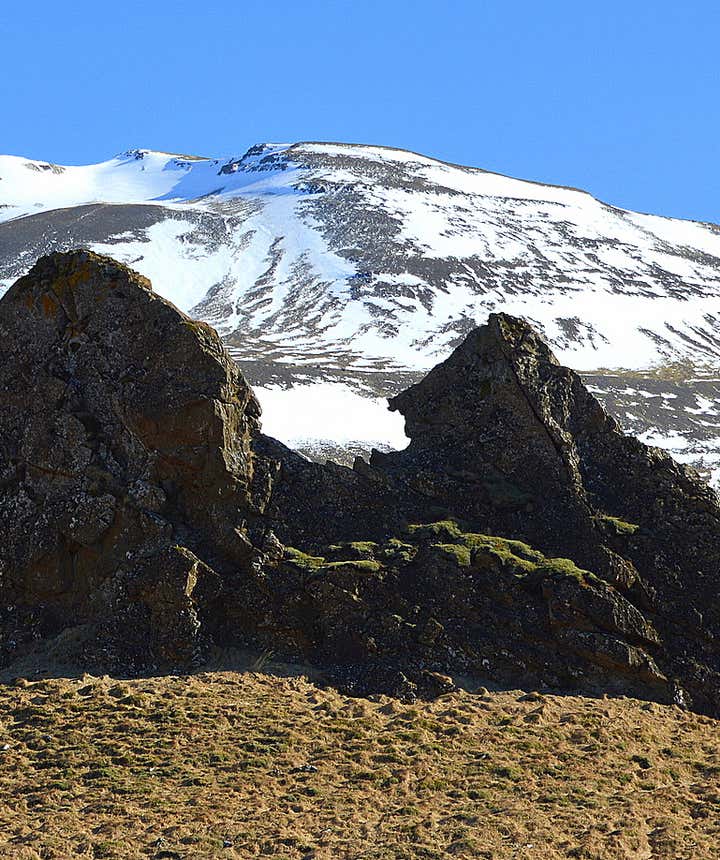
The Giantess Hít in Hítardalur Valley and the Party of the Trolls - Folklore from West Iceland

In this travel-blog I want to tell you about the big troll party in Hítardalur valley in West Iceland, hosted by the giantess Hít and which many of the well-known trolls in Iceland attended.
Top photo: Trolls in Hítardalur valley
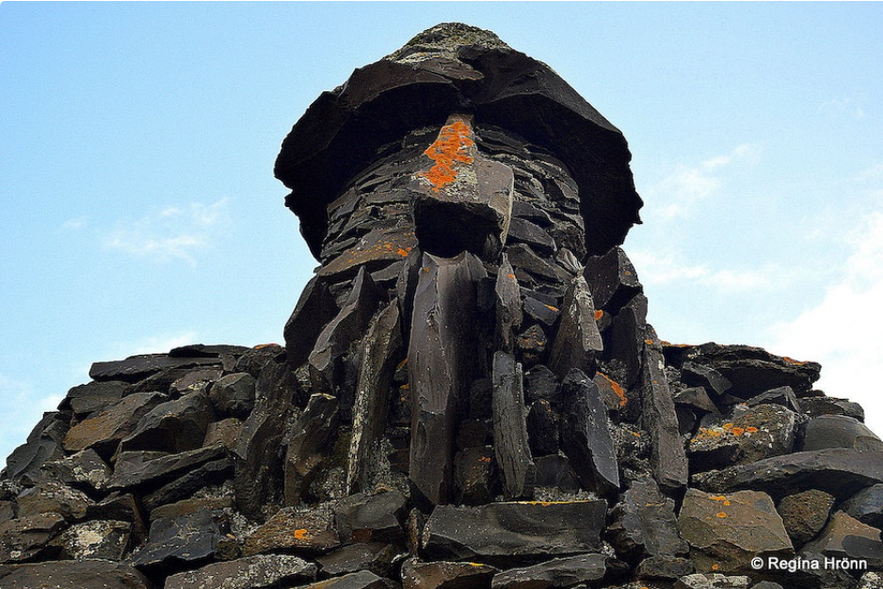
The story is told in one of the later Icelandic Sagas, Bárðar saga Snæfellsáss, dating back to 1280-1390.
The oldest manuscript of Bárðarsaga is a fragment from Pseudo-Vatnshyrna, but it was incorporated in the vellum manuscript of Vatnshyrna in the 14th century along with other Sagas. (Ref.: History of the Trolls - Ármann Jakobsson)
I translated chapter 13 in Bárðarsaga into English:
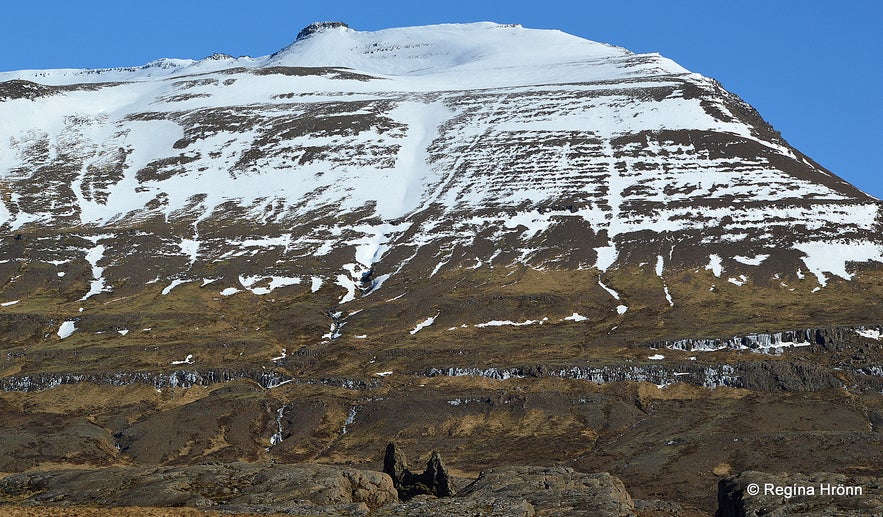
You can see the two trolls at the bottom of this photo, some say that they are Bárður and Hít
"At that time the giantess Hít lived in Hundahellir cave in the valley, which since that time has been called Hítardalur valley.
Hít held a big Christmas party. The first one she invited to the party was Bárður Snæfellsás, and his son Gestur accompanied him and Þorkell skinnvefja (Hít was a good friend of Bárður Snæfellsás).
Guðrún knappekkja and Kálfur her son were also invited. Surtur from Hellisfitjar and Jóra from Jórukleif were also invited.
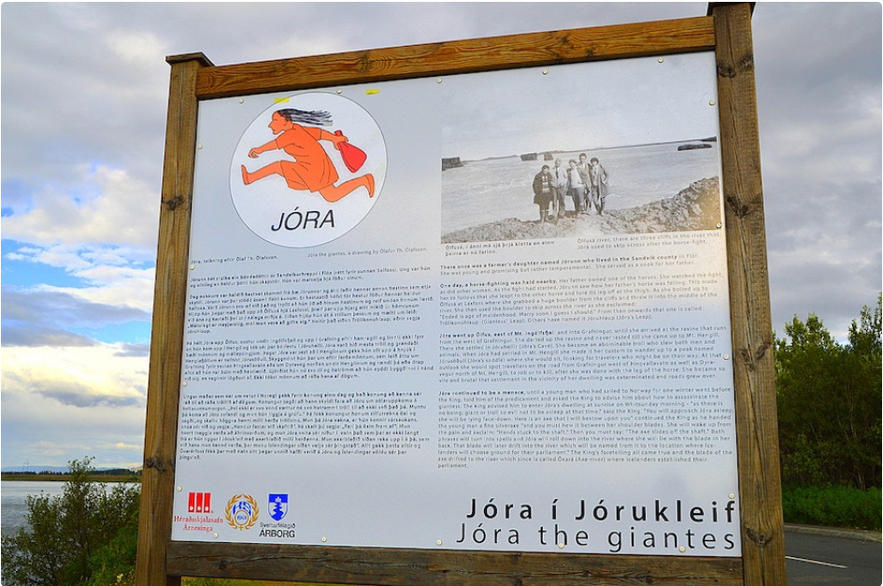
The giant Kolbjörn was also invited. He lives in the cave which is located in Breiðdalsbotnar, out towards the sea in Hrútafjarðardalur valley, where the valley gets shallower west of Sléttafell.
Accompanying Kolbjörn were Gapi and Gljúfra-Geir, who lived in Mt. Háva-Gnúpur in Gnúpsdalur valley, and Glámur and Ámur from Mt. Miðfjarðarnesbjörg. Also at the party was Guðlaugur from Guðlaugshöfði cape.
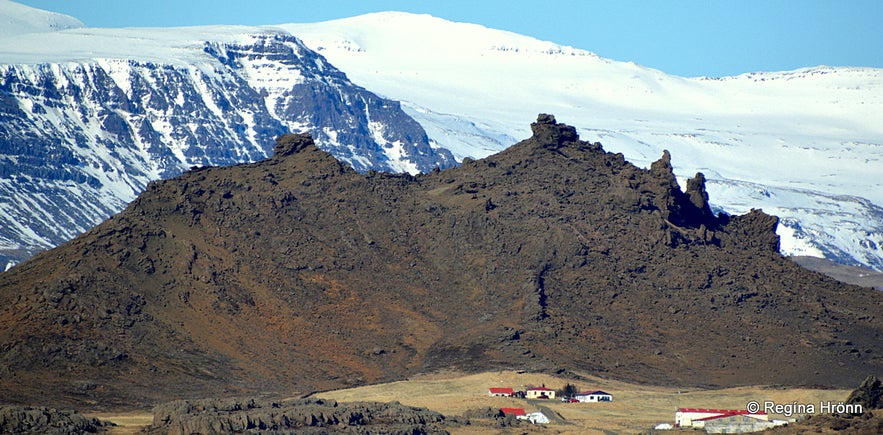 Hundahellir cave is in Mt. Bæjarfell in Hítardalur valley
Hundahellir cave is in Mt. Bæjarfell in Hítardalur valley
The seat arrangement in Hundahellir cave was as follows: In the middle of the bench sat Guðrún knappekkja.
Next to her sat Jóra from Jórukleif Egilsdóttir, but on her other hand sat Helga Bárðardóttir (the daughter of Bárður Snæfellsás), and they were the only ones sitting there. Hít served them.
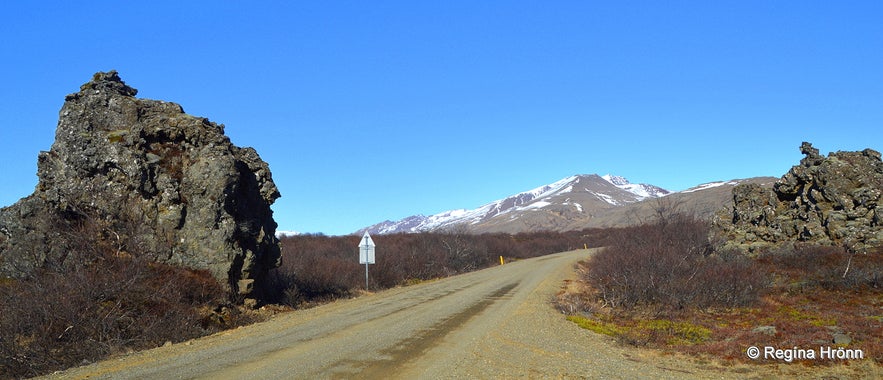 Large lava rocks by the road - are they trolls turned into stone by the first rays of the sun?
Large lava rocks by the road - are they trolls turned into stone by the first rays of the sun?
In the high seat sat Bárður Snæfellsás, further out was Guðlaugur from Guðlaugshöfði cape, but further within was Gestur Bárðarson, then Kálfur and Þorkell skinnvefja.
Opposite Bárður sat Surtur from Fitjar but further within sat Kolbjörn from Breiðadalur valley, then Glámur and Ámur, but further out Geir and Gapi.
Tables were set and magnificent food was put on the table. The trolls started drinking heavily and out of control.
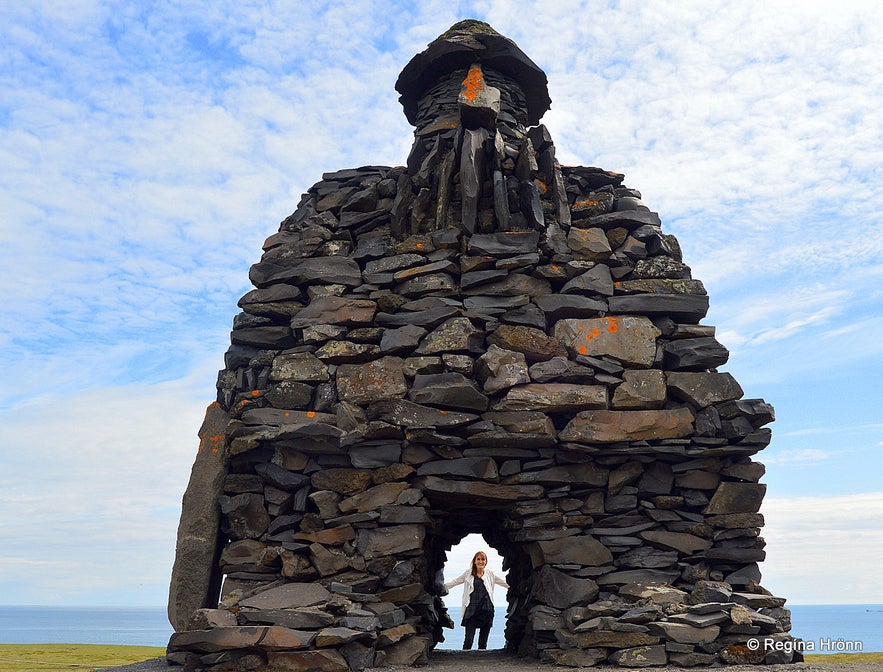 Bárður Snæfellsás is huge compared to me
Bárður Snæfellsás is huge compared to me
When the dinner was over the trolls and Hít asked Bárður what he would like to do for fun, and told him that he was in charge of the home now. Bárður suggested "skinnleikur".
Bárður and Surtur, Kolbjörn, Guðlaugur, and Gljúfra-Geir stood up and played "hornaskinnleikur" with great force and racket. It was obvious that Bárður was the strongest one even though he had grown old.
(Hornaskinnleikur is according to Árnastofnun a combination of a ball game, wrestling, and skinndráttur (two or more people while standing pulled at a wet fur).
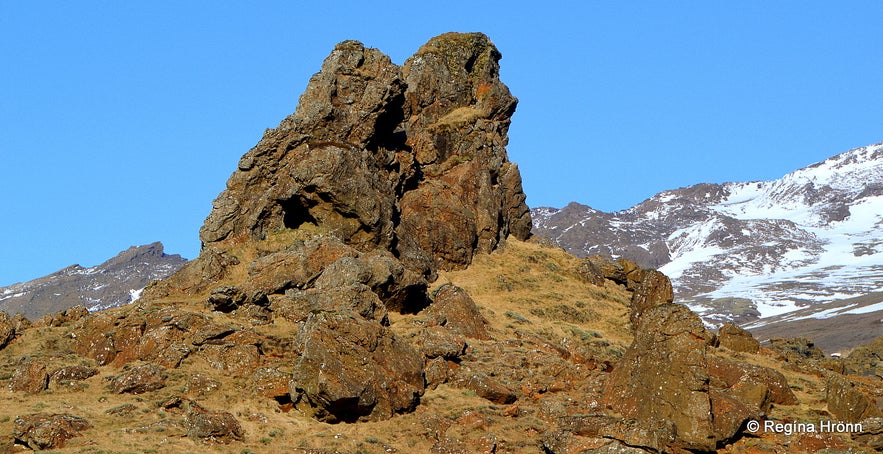 Trolls in Hítardalur valley
Trolls in Hítardalur valley
They used ad large fur of a bear for the skin used in this game and wrapped it up and threw it one to another, the 4 of them, but one of them was outside and his role was to get the bearskin from the others.
It was not advisable to get in the way of these mighty trolls in this rough and tumble skin-throwing game, so most of the trolls stood on the benches, apart from Gestur. He sat still on his bed.
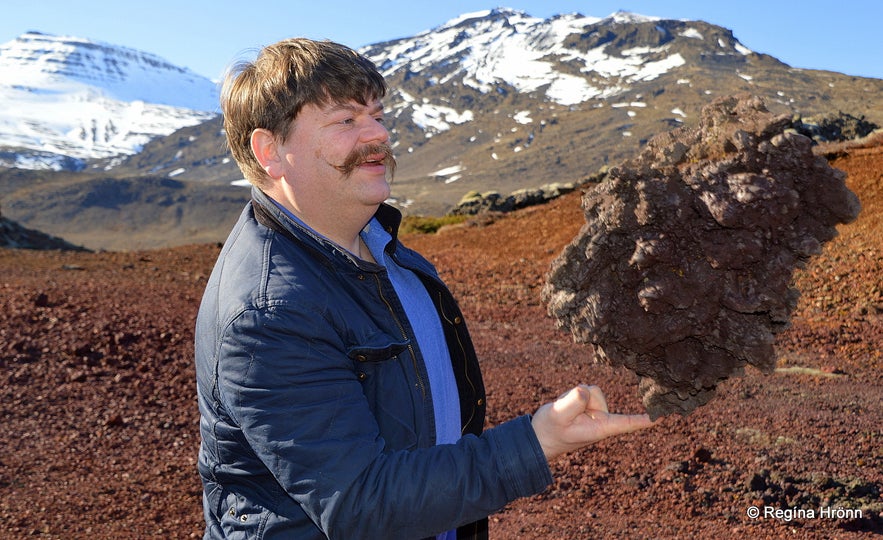 A strong"troll" in Hítardalur - my husband balancing a lava rock on his finger :)
A strong"troll" in Hítardalur - my husband balancing a lava rock on his finger :)
When Kolbjörn was outside he wanted to get the bearskin from Bárður and ran quickly toward him. But as Gestur saw what Kolbjörn was doing he tripped him up by putting his leg in front of Kolbjörn.
The troll fell so hard on the rock that his nose broke and he got covered in blood. A riot broke out amongst the trolls and Kolbjörn wanted to take revenge on Gestur.
Bárður reprimanded them and told them not to mess up the home of his friend Hít: "As she has invited us with love and friendship".
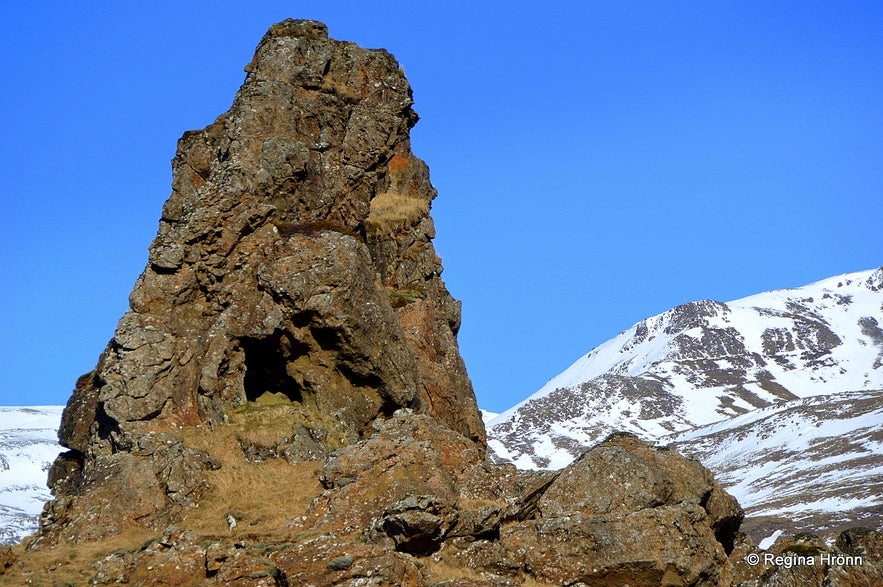 A troll in the valley
A troll in the valley
They had to obey Bárður, but Kolbjörn sulked as he could not get his revenge on Gestur. The trolls now left the party and returned home.
This goes to show that all of the trolls were scared of Bárður as had so often been the case.
As a parting gift, Hít gave Gestur a grey dog named Snati. The dog was a good gift as he was both strong and wise. Hít said that the dog would be better in battle than 4 men. Now Bárður went back home and he and Gestur stayed home for a while".
(Translated into English from Bárðar saga Snæfellsáss - chapter 13 - RHR)
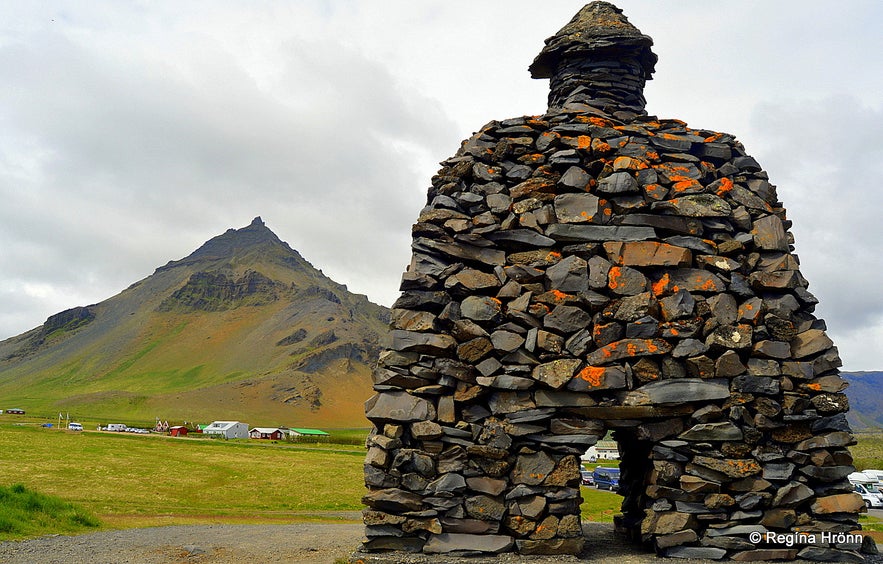 Bárður Snæfellsás and Mt. Stapafell on the Snæfellsnes peninsula
Bárður Snæfellsás and Mt. Stapafell on the Snæfellsnes peninsula
The story didn't end here and in chapter 15 of Bárðar saga Snæfellsáss, we read that Kolbjörn had invited his troll friends to a wedding in a cave in Hrútafjarðardalur, and the troll games at the wedding went way out of control, maybe because Bárður was not at the party to control them.
Kolbjörn had invited the groom (not a troll) to the wedding under false pretenses and meant to kill him and his brother at the wedding.
They were the half-brothers of Gestur (they had the same mother), who was also at the wedding.
Kolbjörn opposed to Gestur's presence, as he had not forgotten that Gestur tripped him over at the Christmas party in Hítardalur valley.
Gestur, by the way, killed all the trolls at the wedding while Kolbjörn and his mother, Skrukka, were sleeping.
And in chapter 16 of Bárðarsaga, Gestur ends up killing Kolbjörn, and Snati the dog proves to be a good and faithful companion and kills Skrukka. - Never a dull moment in Bárðar saga Snæfellsáss!
 A petrified troll in Hítardalur valley
A petrified troll in Hítardalur valley
In chapter 21 of Bárðarsaga we are told that Gestur got Christened and on the night of his Christening, his father Bárður appeared to him in a dream and reprimanded him for leaving the old gods of his forefathers.
As a punishment for doing so, Bárður told his only son that he would lose both of his eyes! When Gestur woke up his eyes were hurting and exploded on that same day and Gestur died. Trolls, eh!
 Bergþór at Bláfell roaming about upcountry in South Iceland
Bergþór at Bláfell roaming about upcountry in South Iceland
Bergþór at Bláfell is not mentioned in Bárðarsaga as being one of the guests at the troll party, but in the folklore which I showed you in my last travel-blog about Bergþór, he is said to have been at the party and is said to have been among the strongest of the trolls:
"At that time the giantess Hít in Hítardalur valley in West Iceland held a big troll party in Hundahellir cave. All the trolls in Iceland were invited including Bergþór.
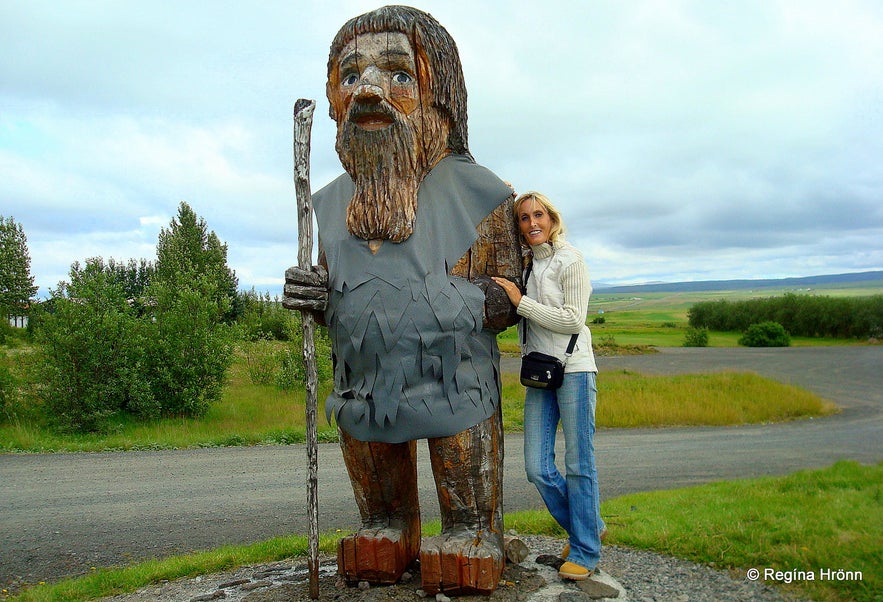 With Bergþór at Bláfell
With Bergþór at Bláfell
After dinner, Hít invited the trolls to entertain themselves, and they chose tests of strength and Bergþór was amongst the strongest of men".
So you see that we sometimes have to read both the Sagas and old Icelandic folklore to get the whole story.
Unfortunately, many of these priceless stories are lost forever.
 Mt. Bæjarfjall by Hítardalur farm
Mt. Bæjarfjall by Hítardalur farm
Hundahellir cave has also been referred to as Hítarhellir cave. It is located at the bottom of the mountain just above the farm and the entrance to the cave has collapsed now.
There are many more caves in Hítardalur and in Mt. Bæjarfell (older name Mt. Húsafell) apart from Hundahellir cave there is Sönghellir (Singing cave), Fjárhellir (Sheep cave), Paradís (Paradise) and Víti (Hell) and some more.
And there is a rock here called Nafnaklettur (the Rock of names), which I missed somehow. There is a myriad of carvings carved by many people on the tuff rock.
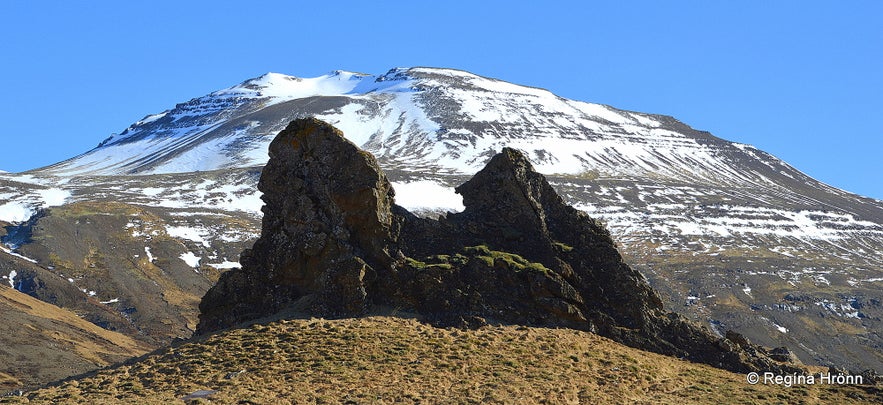 The trolls Bárður and Hít?
The trolls Bárður and Hít?
The chapter about the troll party at Hít in Hítardalur is only one of the chapters in the very interesting Bárðar saga Snæfellsáss.
Some say that Bárður and Hít were turned to stone and refer to 2 rock formations called Drangar by the Hítardalur farm which for sure look like 2 trolls.
But Bárðar saga Snæfellsáss tells us that Bárður disappeared into Snæfellsjökull glacier and protects the Snæfellsnes peninsula. So if this rock formation represents Bárður and Hít, then it must be another Bárður from our old history.
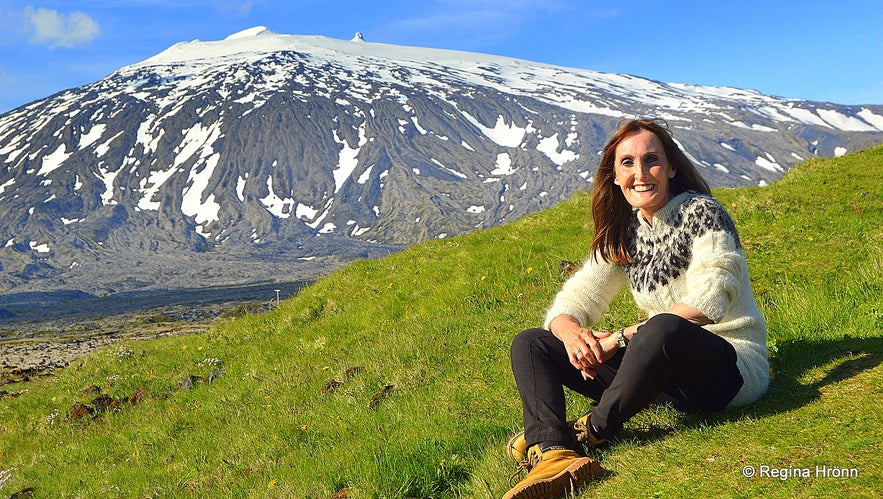 Bárður Snæfellsás is said to reside in Snæfellsjökull glacier now
Bárður Snæfellsás is said to reside in Snæfellsjökull glacier now
I have told you Bárður's story in another travel-blog and shown you the places related to him on the Snæfellsnes peninsula: Bárður Snæfellsás - the Mythical Protector of the Snæfellsnes Peninsula in West Iceland.
Hítardalur valley is located just before you reach the Snæfellsnes peninsula, so it was not far for Bárður to go to the party.
I have read somewhere that there might even be a tunnel from Snæfellsjökull glacier to Hítardalur valley, but I haven't been able to find a reliable source of that tunnel.
 Hítardalur valley
Hítardalur valley
On the 30th of September 1148, the most destructive fire in the history of Iceland took place at the Hítardalur farm, with more than 70 fatalities.
Seven ministers perished in the fire and Bishop Magnús Einarsson of Skálholt (the 4th bishop at Skálholt from 1134-1148).
And many priceless books and artifacts got lost in the fire.
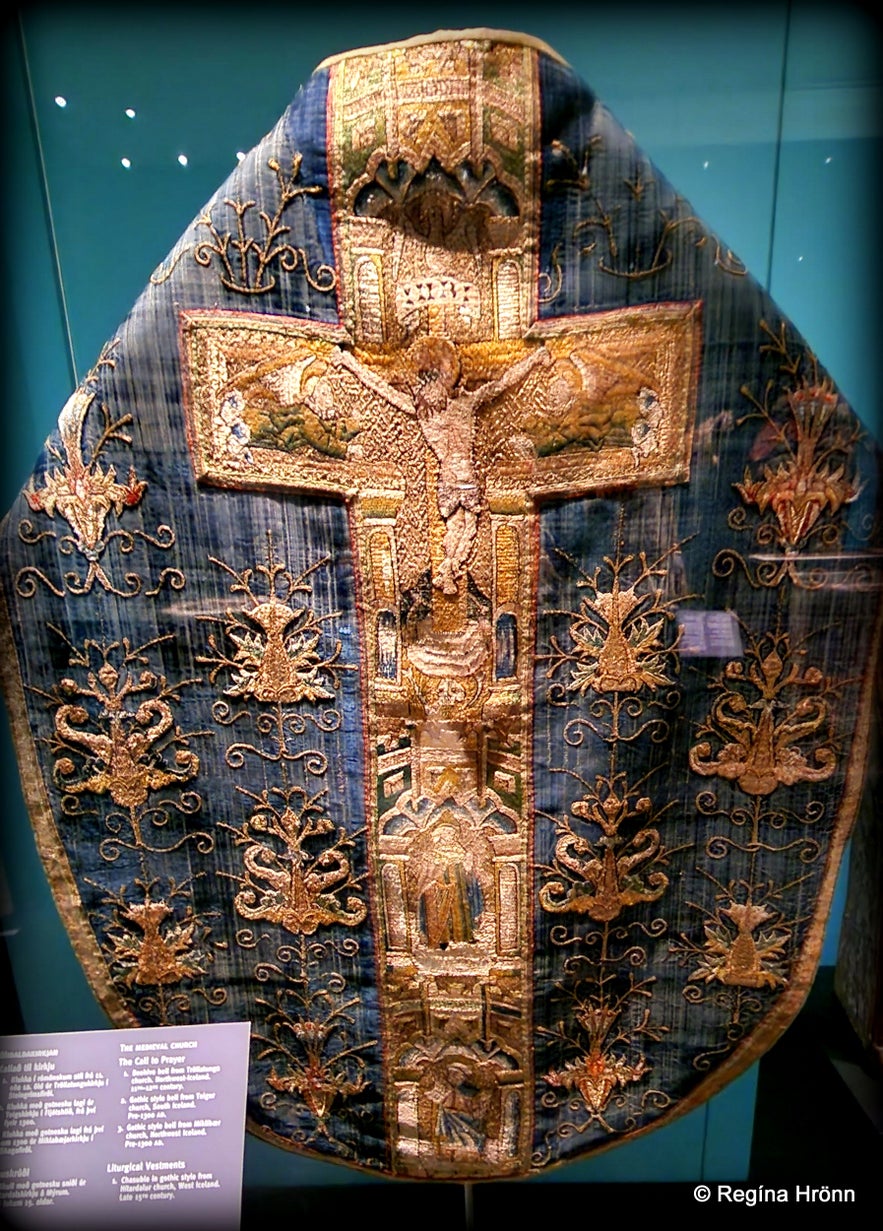 Chasuble from the 15th century from Hítardalskirkja church on display at the National Museum
Chasuble from the 15th century from Hítardalskirkja church on display at the National Museum
Maybe it was after this dreadful event that plans were made to erect a monastery in Hítardalur.
Little is known about the monastery, but it is believed to have been a Benedictine monastery, which operated from 1166 until the first years of the 13th century.
The exact location of the monastery is not known.
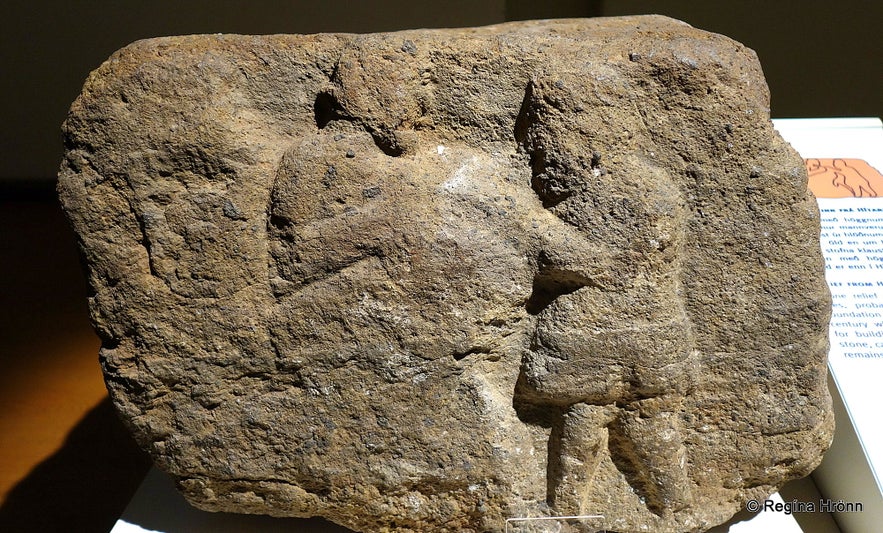 A stone relief from Hítardalur - photo taken at the National Museum of Iceland
A stone relief from Hítardalur - photo taken at the National Museum of Iceland
At Þjóðminjasafnið - the National Museum of Iceland you will find a carved tuff rock, a stone relief depicting two people.
It seems to be from a church foundation and most likely dates back to the 12th century.
Legend tells us that the stone relief, which is half-finished, depicts Bárður Snæfellsás and the giantess Hít. But the question is why would heathen trolls be carved into the church foundation of a Christian church? But who knows?
The stone relief has been at the National Museum of Iceland since 1936.
 Round-up for sheep made of lava rocks in Hítardalur valley
Round-up for sheep made of lava rocks in Hítardalur valley
Another stone relief can still be found by the Hítardalur farm, but there are no other examples of ancient stone reliefs like this one in Iceland.
The National Museum owns a casting of that stone relief.
Páll Guðmundsson (1959), a sculptor in Húsafell in West Iceland has made many such stone reliefs and sculptures which you can now find all over Iceland, kudos to him for a job well done :)
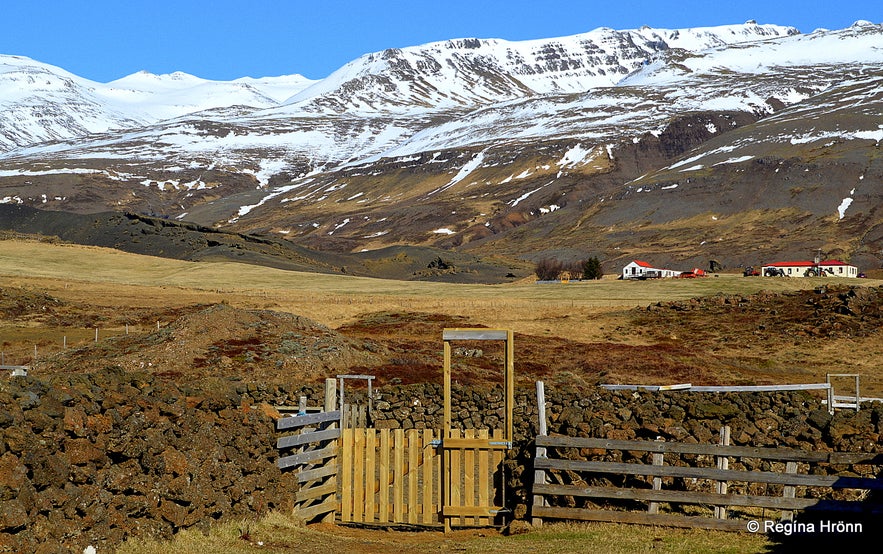 Hítardalur valley
Hítardalur valley
I find the stone carvings very interesting and they add to the landscape. Be on the lookout for them on your travels in Iceland.
You can see some photos of Páll's stone reliefs in my travel-blog about the Spectacular Silver Circle of Iceland.
Lake Hítarvatn
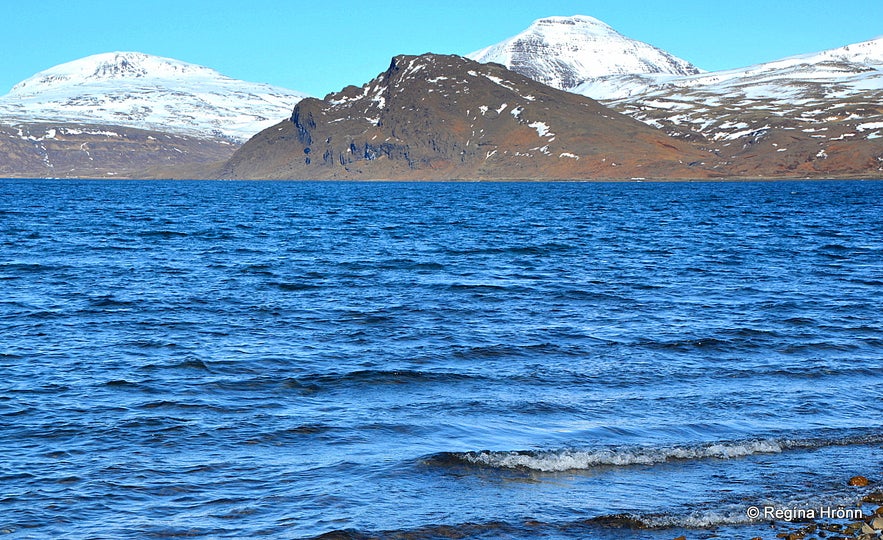 Lake Hítarvatn and Mt. Foxufell
Lake Hítarvatn and Mt. Foxufell
After exploring the Hítardalur valley, we drove to Lake Hítarvatn where the river Hítará has its source, 25 km away from the sea. There is good salmon fishing in the lake.
Many mountains surround Lake Hítarvatn including Mt. Foxufell. In that mountain is Bjarnarhellir cave. Runes were found in the cave, and a carved seat, which might be very old.
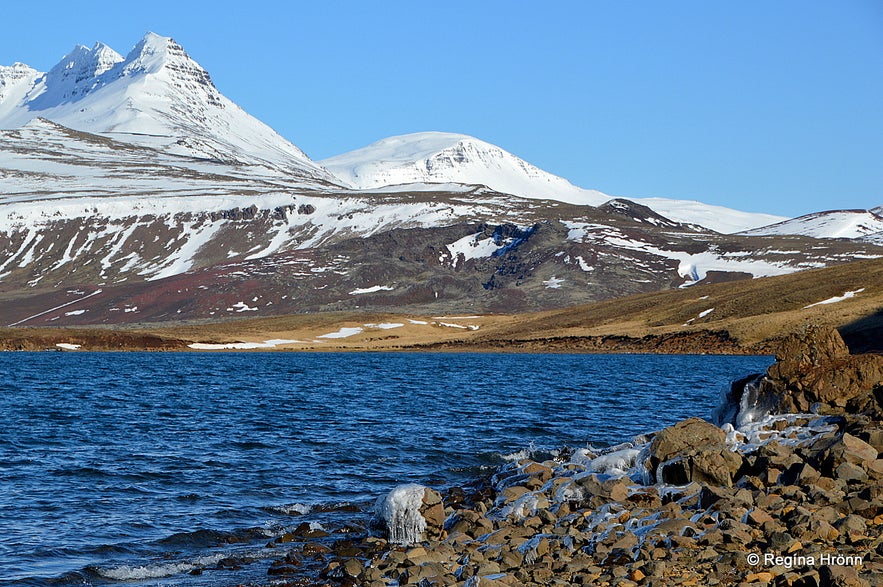 Lake Hítarvatn
Lake Hítarvatn
Here by the lake is Hólmur, where Björn Hítdælakappi (950) lived. Bjarnar saga Hítdælakappa tells us his story.
The story tells us about Björn Arngeirsson and Þórður Kolbeinsson of Hítarnes and the woman they both loved, Oddný eykyndill Þorkelsdóttir.
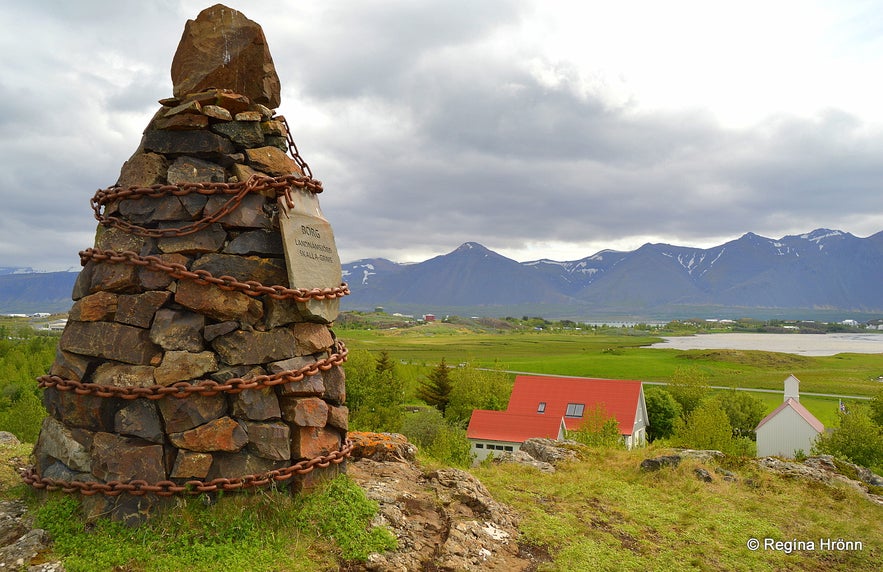 Borg at Mýrar
Borg at Mýrar
Björn's maternal grandmother was the sister of Egill Skallagrímsson, whom I have told you about in another travel-blog: The Saga of the Viking Egill Skallagrímsson & the 9 Cairns.
Þórður was the courtier of earl Eiríkur Hákonarson but was not well-liked amongst the common people as he liked to ridicule people and Björn was often on the receiving end of his mockery.
Björn sought shelter from Þórður for 5 years with his relatives at Borg at Mýrar when he was young, so their dispute started early in the saga.
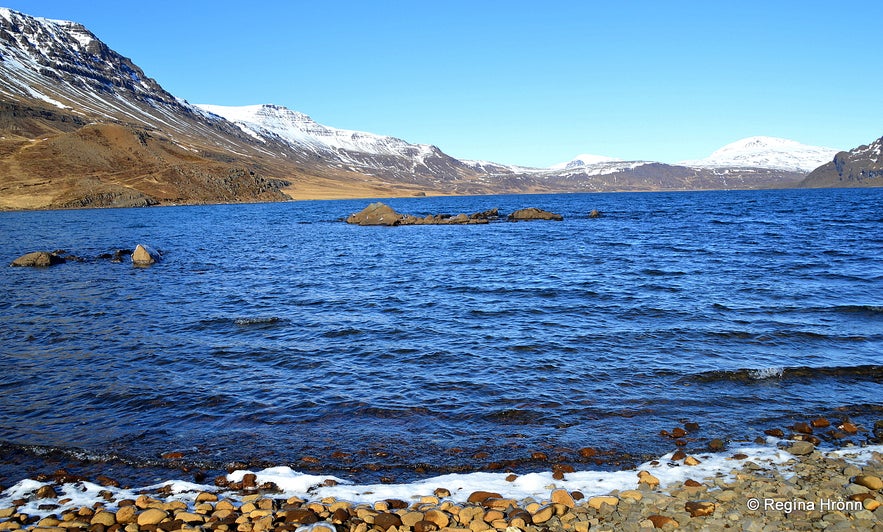 Lake Hítarvatn
Lake Hítarvatn
Oddny was engaged to marry Björn, but Þórður tricked her into marrying him instead by telling her that Björn was dead, thus betraying the trust of Björn. This, of course, made Björn his sworn enemy.
It is an interesting story with many plots and reconciliations, but to cut it short then Þórður ended up killing Björn by Hvítingshjallar and Klifsgil close to Björn's home.
Björn defended himself valiantly, but in the end, he was one-handed on his knees with big and sharp shears he had for cutting horses' manes - and was eventually killed.
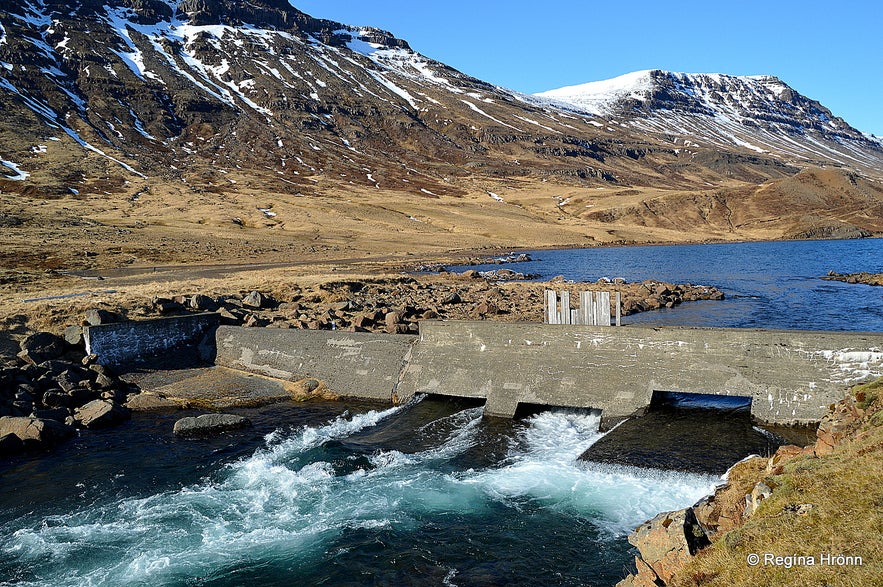 A dam in the Hítará river
A dam in the Hítará river
Björn had been trying to reach Grásteinn rock in the Klifsdalur valley to seek shelter from his enemies by the rock but never managed to reach the rock.
Þórður, after killing Björn, cut off his head to show to Þórdís, Björn's mother. He actually threw her son's head at her and told her that it needed washing! She replied with a well-deserved insult.
The aftermath of the slaying of Björn was amongst the biggest aftermaths known for one man, the saga tells us, and Þórður had to pay a huge amount of money to settle the case, 900 silver!
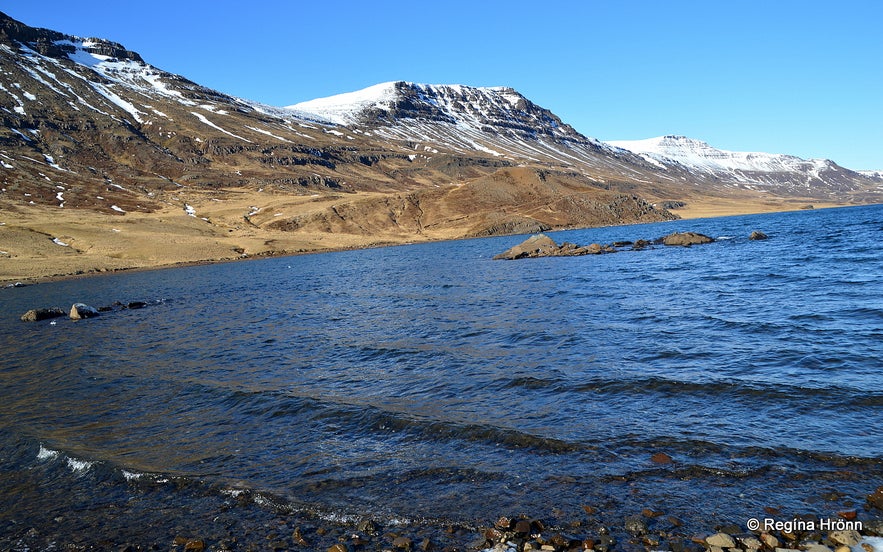 Lake Hítarvatn and Hvítingshjallar
Lake Hítarvatn and Hvítingshjallar
The same happened to Grettir the strong when he was killed, his head was cut off as proof to show to Ásdís, his mother at Bjarg.
Grettir the Strong from the Saga of Grettir stayed for 3 winters of his 19-year outlawry in Grettisbæli in Mt. Fagraskógarfjall in Hítardalur.
Grettir sought shelter with Björn Hítdælakappi who often sheltered outlaws.
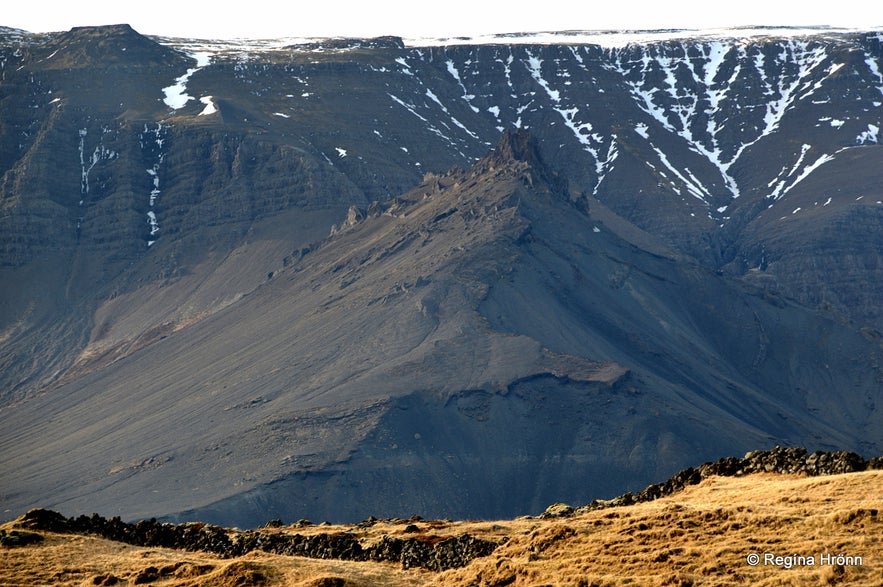 Grettisbæli in Mt. Fagraskógarfjall
Grettisbæli in Mt. Fagraskógarfjall
Björn told Grettir that he could stay in a protruding mountain in Mt. Fagraskógarfjall, which from then on was called Grettisbæli - the Lair of Grettir.
I tell you about Grettir and his time in Grettisbæli including my favourite account in Grettissaga in my next travel-blog: Grettir the Strong and Grettisbæli Lair in Hítardalur Valley in West Iceland
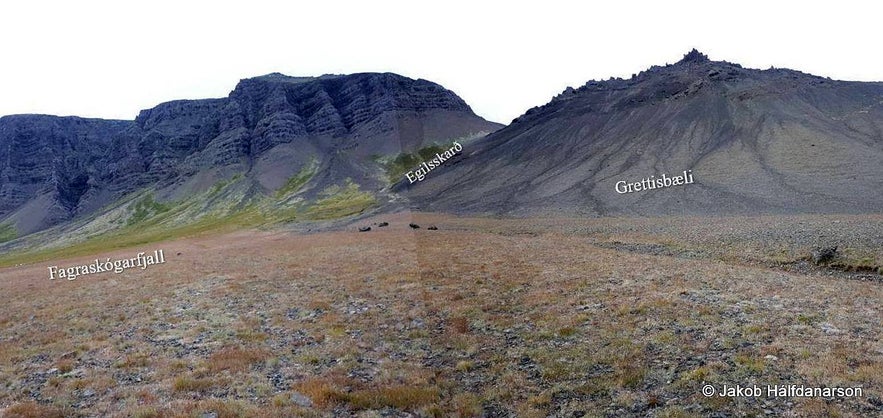 Grettisbæli in Mt. Fagraskógarfjall
Grettisbæli in Mt. Fagraskógarfjall
Hítará river is a very popular salmon river and runs through the Hítardalur valley and under road 54, where it creates the small Brúarfoss waterfall, and into the Akraós estuary by Hítarnes promontory.
At Hítarnes lived Þórður Kolbeinsson, who killed Björn Hítdælakappi. Hítará river and Brúarfoss waterfall
Hítará river and Brúarfoss waterfall
When a big avalanche fell from Mt. Fagraskógarfjall back in the summer of 2018, we were worried that it would block the river, but the following day the river found a new course across the lava and into the river Tálmá.
Here you can see the avalanche on a map from the Meteorology office of Iceland.
Staðarhraunskirkja church
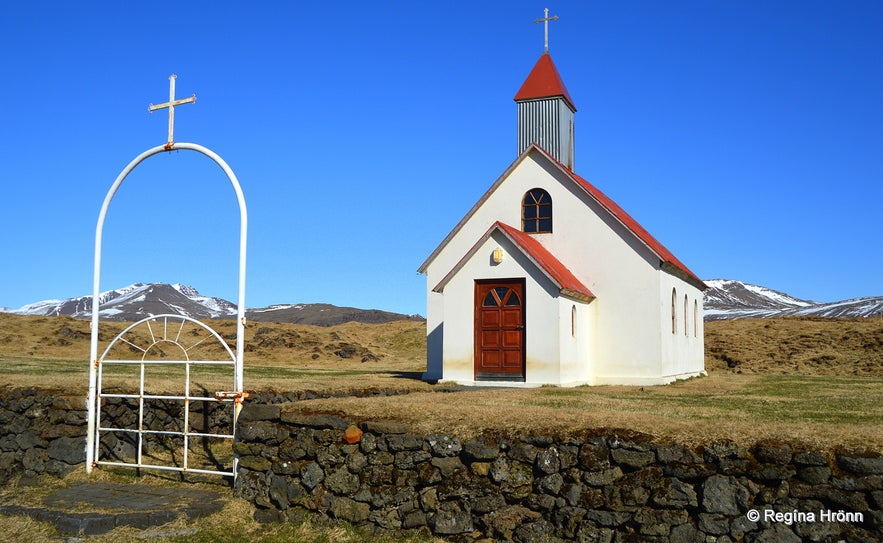 Staðarhraunskirkja church
Staðarhraunskirkja church
South of Hítardalur valley you will find Staðarhraunskirkja church. We stopped by it on our way into the Hítardalur valley, but it was locked, so we decided to have a look at it again after we had visited the valley.
The farmer was kind enough to open the church for us and show us inside.
The current Staðarhraunskirkja church was consecrated in 1889. In 1954 the timber church was encased in concrete.
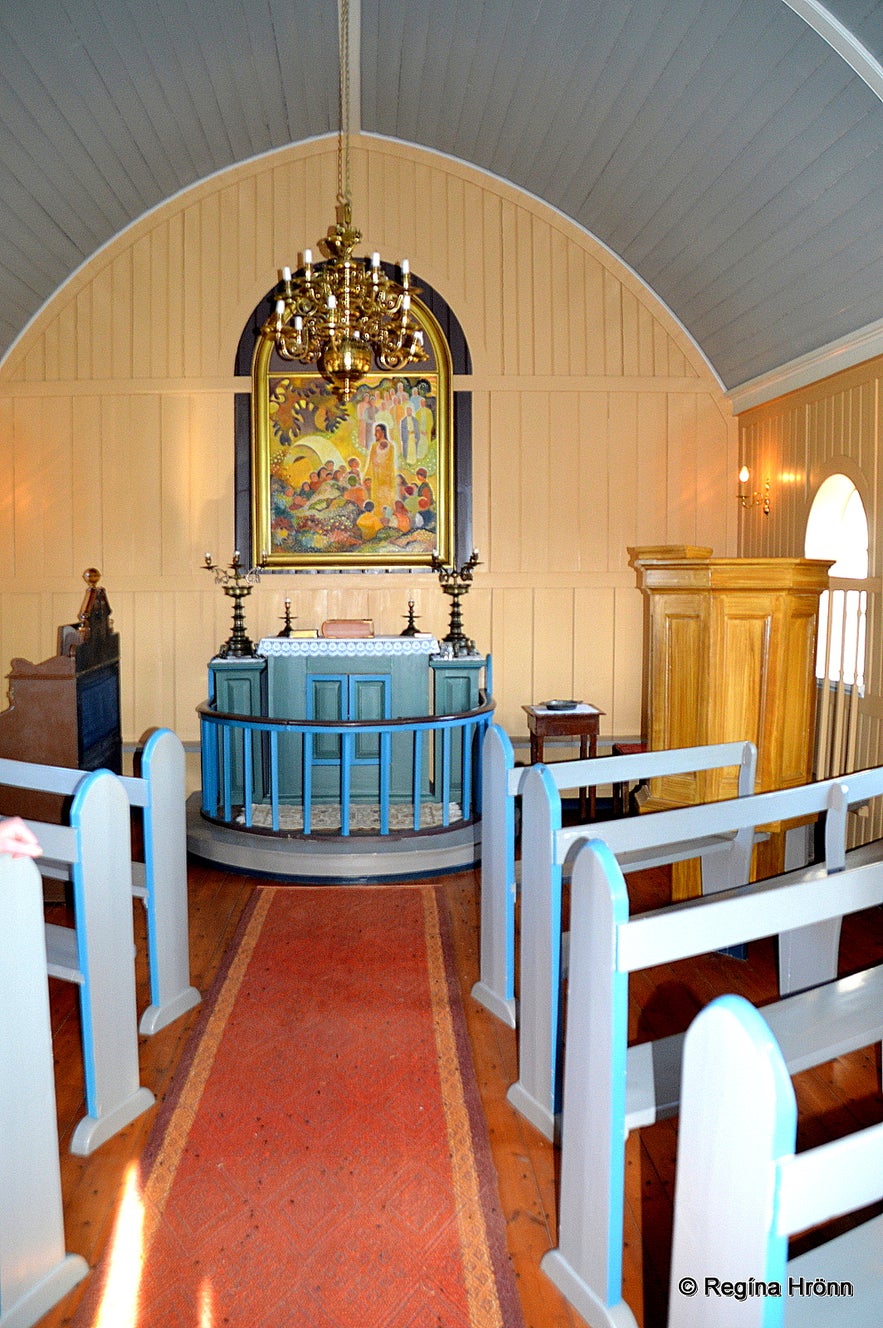 Inside Staðarhraunskirkja church - the altarpiece was painted in 1957
Inside Staðarhraunskirkja church - the altarpiece was painted in 1957
A former church at the Hítardalur farm was one of the best and richest rectories in the Skálholt diocesan, with many a fine minister serving at the church.
There was a church here undir Hrauni from before 1200 from the time Bishop Þorlákur helgi was the bishop at Skálholt.
In a muniment from 1185, it is said to be dedicated to the Virgin Mary.
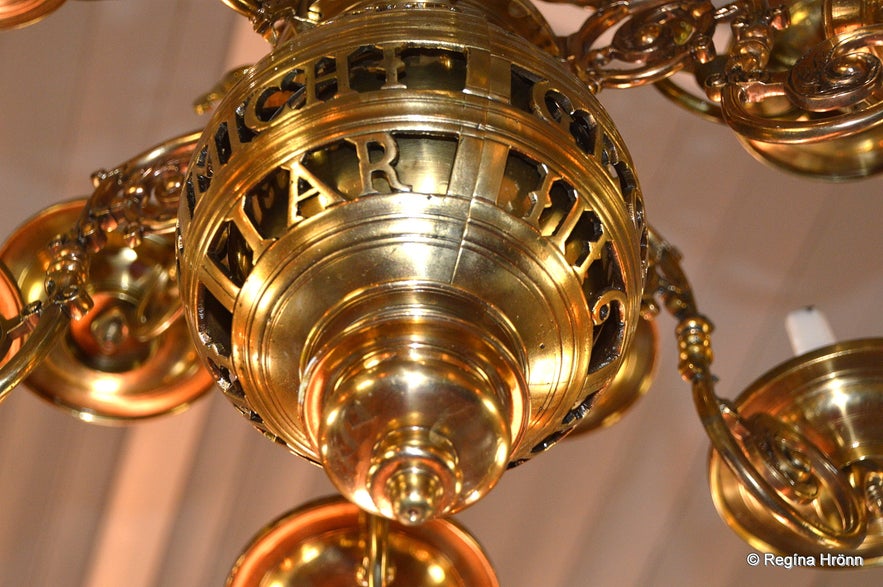 The copper chandelier dates back to 1616 - it was moved from Hítardalskirkja church.
The copper chandelier dates back to 1616 - it was moved from Hítardalskirkja church.
In 1875 Hítardalskirkja church was abolished by a royal decree, and in 1879 Staðarhraunskirkja church and Álftártungukirkja rectories (close by, which we also visited) were united with the Hítartungu rectory and shortly after (1884) the Hítardalskirkja church was demolished.
Some of the artifacts from Hítardalskirkja church were moved to Staðarhraunskirkja church, like the copper altar candlesticks which date back to around 1300.
And the copper chandelier from 1616 in my photo above.
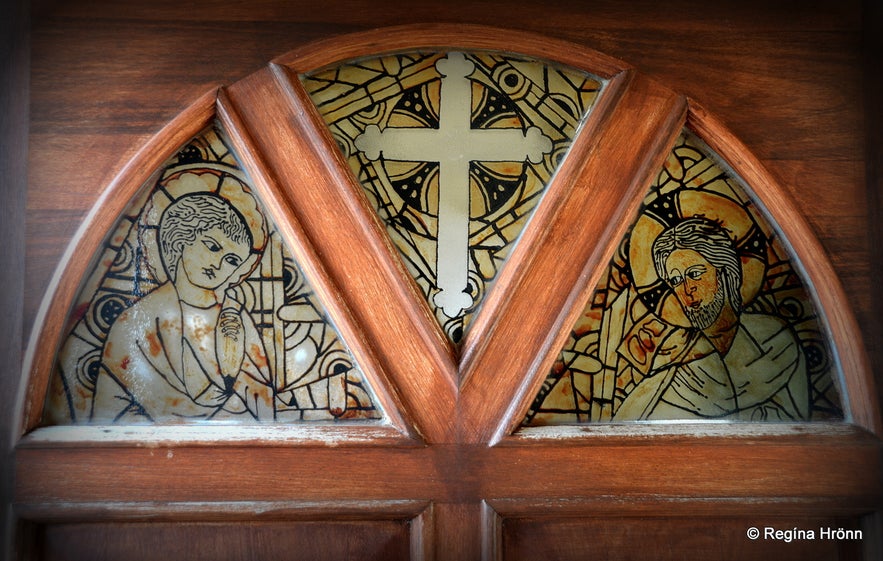
Staðarhraunskirkja church
There is an account from Bjarnar saga Hítdælakappa that Björn and Þórður met here to try to reconcile.
The meeting was in vain though as these 2 enemies couldn't agree on the number of libellous verses they had made about each other. Björn turned out to have made one more than Þórður and didn't want Þórður to add to his insults by making a new libellous verse.
They ended up throwing more libellous verses at each other and reconciliation was out of the question.
 Staðarhraunskirkja and Mt. Fagraskógarfjall
Staðarhraunskirkja and Mt. Fagraskógarfjall
It was now time to leave the historical Hítardalur valley. Mt. Fagraskógarfjall in my photo above and below defines the boundaries of the valley.
Often we pass historic valleys on our way to better-known places and miss the treasures these valleys keep. I love visiting such valleys and have written several travel-blogs about the valleys of Iceland.
A visit to Fnjóskadalur valley in North Iceland
Aldeyjarfoss waterfall in Bárðardalur valley in North Iceland
Lundarreykjadalur valley in West Iceland and the Natural Hot Pools
Reykjadalur valley - bathe in a hot river in South Iceland
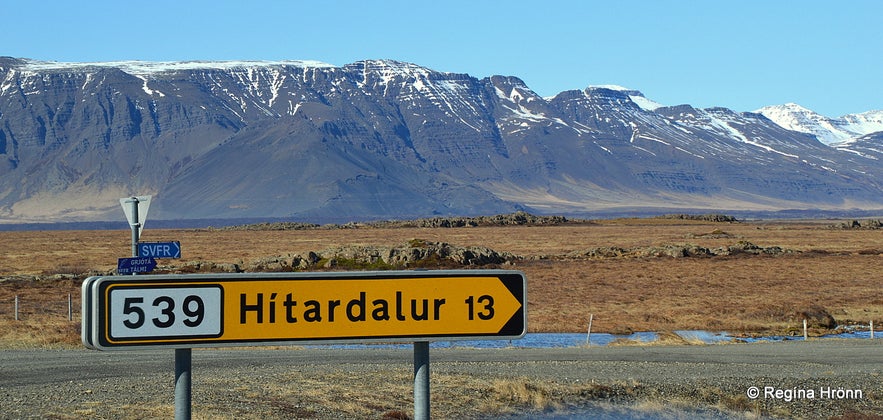 Hítardalur is on road 539 - you turn from road 54
Hítardalur is on road 539 - you turn from road 54
Road 54 leads to the Snæfellsnes peninsula, which is one of the most popular places to visit in Iceland.
If you want to see what it looks like then I have written a 5-part travel guide about the peninsula in chronological order.
Here is part I: The Magical Snæfellsnes Peninsula in West Iceland - Part I
 Arnarstapi on Snæfellsnes is a popular attraction on the beautiful peninsula
Arnarstapi on Snæfellsnes is a popular attraction on the beautiful peninsula
In other travel-blogs I have told you the story of some of the trolls who attended the party at Hítardalur:
The gentle Troll Bergþór in Mt. Bláfell - Icelandic Folklore from South Iceland
The temperamental Giantess Jóra in Jórukleif and the Lava Pots by Selfoss in South-Iceland
Bárður Snæfellsás - the Mythical Protector of the Snæfellsnes Peninsula in West Iceland
And not far from here, another troll story happened:
Kerlingarskarð Pass in Snæfellsnes in West-Iceland - the Folklore of the Giantess & her Fiancé
 Mt. Fagraskógarfjall
Mt. Fagraskógarfjall
If you want to hear more about these half-trolls then I have told you about another troll party at Mt. Ármannsfell in South Iceland and the famous troll games on Hofmannaflöt plains where the half-trolls and the strongest men of Iceland competed against each other to find out who was the strongest amongst them: Ármann in Mt. Ármannsfell and the Troll Games on Hofmannaflöt Plains in South Iceland.
The story is told in Ármannssaga hin yngri.
Have a lovely time in Hítardalur valley :) Here is the location of the valley on Google maps.
Ref.:
Bárðar saga Snæfellsáss - chapter 13.
Sarpur - Myndasteinn úr Hítardal
Örnefnasafn Árnastofnunar - Hítardalur
Tímarit - Mbl. 1954 - Í Hítardal
Kortlagning klaustra á Íslandi - Hítardalur
Varðveittir gripir úr íslenskum miðaldaklaustrum
Kirkjur Íslands - volume 15
他おすすめのブログ
ブルーラグーン - Blue Lagoon
まずブルーラグーンという世界的に有名なスパについて紹介したいと思います。アイスランドの首都から車で30分のところにあるとても綺麗な温泉施設です。わき水のほかにアイスランドには地熱発電施設がたくさんあり、そこからの温水を利用しています。 でも、Blue Lagoonの魅力はそれだけではありません。ラグーンのミネラルの多くは、あなたの肌のに非常に良いです。例えば、シリカを顔に付けたら、肌がとてもっと読むIcelandic Nature - アイスランドの自然
アイスランドの自然 多くの観光客が自然を見るためにアイスランドに来ると思います。自然は汚くなくて、とても綺麗です。アイスランドの自然はほとんど、昔のままであると思います。 アイスランドの自然でいろいろなアクティビティができます。自分が一番好きなアクティビティは山のハイキングです。夏によく家族とハイキングトリップに行きます。普通に15-20人のグループと行って、みんなとキャビンで泊まります。もっと読むアイスランドの魚料理
アイスランドの魚料理。 アイスランドの経済の最も重要な業種は観光と漁業です。従ってアイスランド人は魚料理がとても好きです。それは魚が新鮮だからだと思います。日本の魚料理と違うのは作り方だと思う、生で食べるよりアイスランド人が普通に魚を焼く。でも日本みたいに全体調理しなくて、アイスランド人が魚を一人分のサイズに切って調理するんです。 魚料理と釣りが好きなら、アイスランドに来たらとてもいもっと読む

アイスランド最大の旅行アプリをスマートフォンにダウンロード。旅のすべてを1か所で管理できます。
アイスランド最大の旅行マーケットプレイスをポケットに。スマートフォンのカメラでQRコードを読み取り、表示されるリンクをクリックしてください。電話番号またはメールアドレスを入力すれば、SMSやEメールでもダウンロードリンクを受け取ることができます。
















